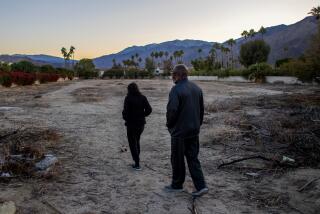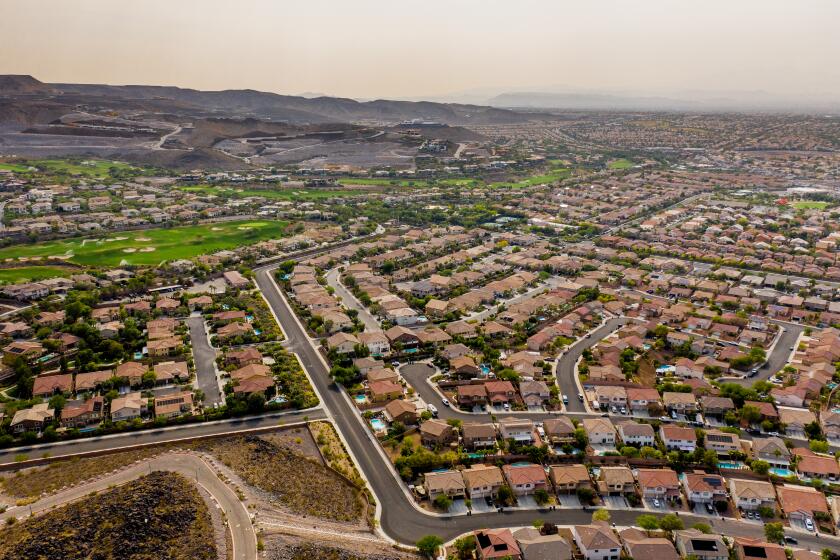Southern California’s first luxury LGBTQ retirement community is waiting in the wings
Long a popular retirement harbor for gay men, Palm Springs will soon welcome what’s perhaps the ultimate queer golden-age ticket: a luxury condominium community designed for active LGBTQ seniors.
Set to break ground in January, the $60-million $70-million amenity-rich Living Out complex is the vision of longtime developer partners Paul Alanis and Loren Ostrow of Los Angeles-based KOAR International. Located on a prime nine-acre East Tahquitz Canyon Way lot that’s an easy walk to downtown, the resort-style property’s 105 one- and two-bedroom units will be priced from $699,000.
Although a number of LGBTQ retirement villages exist nationwide — both for wealthy and low-income residents — the developers bill their project as the first of its kind in Southern California. They say it will be a standout in terms of lessening what many seniors face: loneliness.
“We’re not just building condominiums for people, we’re providing them with all sorts of opportunities to develop community, to have interaction,” said Ostrow, who expects a summer 2021 opening.
For the LGBTQ population, often childless and less biological-family-centric, isolation and its repercussions can be a grim reality of aging. A 2018 AARP study found that 76% of LGBTQ Americans worry about “having adequate family and/or social supports to rely on as they age.” The group “can be surprisingly weak in having support from their family,” according to the study.
Socialization has been baked into Living Out’s three-story Midcentury Modern design, its Y shape affording views of three mountain ranges and $5 million in site landscaping.
Among the comforts and diversions: two pools, pickleball and bocce ball courts, a dog park, putting green, gardens, a salon, screening room, restaurant and bar, gym, massage studio, and card and game rooms. A nearly 5,000-square-foot retail space fronting East Tahquitz Canyon Way will include a pet hotel and full-service grooming.
As an opulent oasis with plenty of bustle, the complex will engender “kind of like a never-ending party,” Palm Springs City Councilman J.R. Roberts said. Although that statement might veer to hyperbole, Roberts explained that Living Out’s siting is optimal — amid the city’s booming gay bar and nightclub scene known for uproarious drag shows, largely favored by an aging Palm Springs demographic that grew up socializing at bars, not on apps.
As other cities have seen a decline, Palm Springs gay bars are “increasing in number and they’re packed,” Roberts said. “People don’t want to be home by themselves. They want to meet and socialize.”
With such rainbow resonance — “we’re kind of ground-zero queer here,” Roberts said — the complex has received considerable early interest, according to its developers. Indeed, Living Out is located in a city that’s “the top LGBT-friendly place for gay senior travel and retirement,” according to a 2019 ranking compiled by AARP Travel Center and Expedia.
Coachella Valley’s first and — so far — only LGBTQ-centric retirement community, North Palm Springs’ Stonewall Gardens, opened in 2014. The facility’s 24 bungalow-style apartments include an option for 24-hour on-site care. Living Out will recommend LGBTQ-supportive in-home care companies, should residents require them.
Other such Palm Springs developments have failed — most notably plans to turn the 10-acre 1934 Racquet Club (an early celebrity haunt partly destroyed by fire in 2014) into a retirement community and, later, a housing development, both geared to queer folk.
Alanis and Ostrow believe their four-decade working relationship — during which they’ve overseen $3 billion in development, as diverse as Embassy Suites and riverboat casinos — represents a solid bet.
“This is a project of passion,” said Ostrow, who has served 20 years on the Los Angeles LGBT Center’s board of directors. However, that still trails Living Out’s director of marketing and sales, LuAnn Boylan, who has served 27 years. Ostrow has also spent nine years on the National Gay & Lesbian Task Force board.
Those enduring associations with the LGBT Center, the world’s largest such organization, lend the project serious cred, they said.
Most gay retirement complexes are havens for a population that can be shunned, disrespected and abused when living in conventional facilities. The Living Out team acknowledged that’s not much of a concern in Palm Springs, ranked first in the state as having the most same-sex couples.
Rather, Living Out provides a “comfort level with culture, with tradition,” Ostrow said, pointing to other communities for Jewish and Chinese retirees. (A Florida retirement home, Nalcrest, is exclusive to letter carriers; it curiously lacks home mail delivery but understandably forbids dogs.)
KOAR hopes to replicate its vision in other cities; initial markets may include San Diego, Dallas and Fort Lauderdale.
Living Out homeowners are expected to skew about 10 years younger than Stonewall residents and those at other senior living communities, a nice parallel to Palm Springs’ recent youthful reinvention as the capital of cool, the developers said.
“Palm Springs is not a place where people go to just get old any longer,” Ostrow said. “To be interacting with younger people can only be good for senior citizens.”






